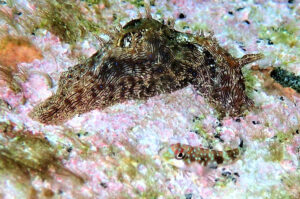Lined Sea Hare, Stylocheilus striatus



 Lined Sea Hare, Stylocheilus striatus. Underwater photographs taken in Zihuatanejo Bay, Guerrero, March 2019 to January 2023. Photographs courtesy of Ron Woheau, Zihuatanejo. Identifications courtesy of Bob Hillis, Ivins, Utah.
Lined Sea Hare, Stylocheilus striatus. Underwater photographs taken in Zihuatanejo Bay, Guerrero, March 2019 to January 2023. Photographs courtesy of Ron Woheau, Zihuatanejo. Identifications courtesy of Bob Hillis, Ivins, Utah.
 Lined Sea Hare, Stylocheilus striatus, Mating Chain. The initial sea hare in the above chains ac as a female for the one behind it, who will then get mounted by another sea hare, etc. creating a chain of sea hares with each “hare” acting as a male for the one in front of it and a female for the one behind it. Underwater photograph taken in Bahia de La Paz, Baja California Sur, July 2019. Photograph, identification and related productive discussions courtesy of Abigail Cannon, La Jolla, California.
Lined Sea Hare, Stylocheilus striatus, Mating Chain. The initial sea hare in the above chains ac as a female for the one behind it, who will then get mounted by another sea hare, etc. creating a chain of sea hares with each “hare” acting as a male for the one in front of it and a female for the one behind it. Underwater photograph taken in Bahia de La Paz, Baja California Sur, July 2019. Photograph, identification and related productive discussions courtesy of Abigail Cannon, La Jolla, California.
Phylogeny: The Lined Sea Hare (Quoy and Gaimard, 1832) is a member of the Aplysiidae family of Sea Hares. The genus is one of ten genera in this family and there are three species in this genus. They are also known as the Blue-ring Sea Hare and the Furry Sea Hare and in Mexico as Liebre de Mar Rayada.
Morphology: Sea hares derive their name from their rounded body outline and long projecting rhinophones (chemosensory organs that detect “scent” in the water and water motion), attached to the head, which give them the shape of a sitting rabbit. They are large gastropod mollusks. They lack the external shell of most gastropods and instead have a small, flimsy, shell located within the mantle. The mantle also covers the gills and other organs. Sea hares have wing-like flaps (parapodia) along their sides. These parapodia allow the animal a limited amount of swimming ability. Lined Sea Hares have a lower profile and a longer tail than most Sea Hares. They are light brown with fine, dark brown, lines running the length of their body. At various locations on their body, they have small dark spots, with pink or blue centers. Lined Sea Hares are fairly small, reaching only 6.5 cm (2.5 inches) in length.
Habitat and Distribution: Lined Sea Hares are found on sand or rock, usually in areas of dense algae growth. They live intertidally, and to a depth of around 12 m (40 feet). They are circumtropical in distribution. In Mexican waters they are found throughout the Gulf of California, and south along the mainland coastline to Guatemala. They are more common in the northern and southern portions of the Sea of Cortez than they are in the central portion. The are absent from the west coast of the Baja Peninsula. Previous distribution records for this species included the incorrectly identified Long-tailed Sea Hare, Stylocheilus longicauda, a pelagic species.
Diet: Lined Sea Hares are grazers, feeding on blue-green algae (Cyanobacteria). This blue-green algae forms a film or mat over the bottom substrate. Occasionally they form swarms that migrate across the bottom stripping the substrate of cyanophytes. When food is exhausted, entire populations may release from the bottom and drift off on the current with the animals using mucous strings as “sails.” This can result in large numbers suddenly appearing in new areas when currents concentrate and deposit drifting swarms.
Predators: Lined Sea Hares can release a purple dye, as a defense mechanism, when threatened. However they are still consumed by crustaceans, fish, nudibranchs and sea stars.
Reproduction: Lined Sea Hares are simultaneous hermaphrodites (having both male and female reproductive organs). Reproduction is sexual, with internal fertilization. Mating is often a group activity, with individuals forming mating chains. The fertilized eggs are laid in a tangled, gelatinous, golden-brown egg string. The eggs hatch, in about one week, as veliger larvae with small calcareous shells. They stay in this planktonic stage for a short period before settling on the bottom and undergoing metamorphosis. During metamorphosis they lose their shells and become juvenile sea hares.
Ecosystem Interactions: This is no documentation of Lined Sea Hares involvement in commensal, parasitic, or symbiotic relationships. They play an important role in keeping cyanobacteria under control and from becoming an overly dominant in an ecosystem.
Human Interactions: Lined Sea Hares have very little direct impact on human activities. From a conservation perspective they have not been formally evaluated however they are fairly common with a wide distribution and should be considered to be of Least Concern.
Synonyms: Aplysia striata, Notarchus lineolatus, Notarchus stimpsoni, Stylocheilus lineolatus, and Stylocheilus quercinus.